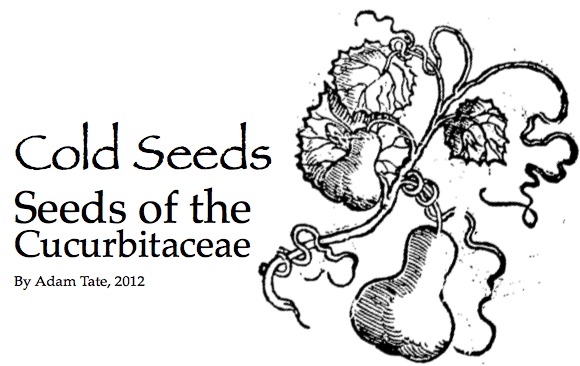 Introduction
IntroductionThe Four Greater Cold seeds formed a cornerstone in Western Pharmacy for 2 millennia. They are often used in cooling compounds, and in compounds to nourish and moisten, such as would be considered Heat-clearing Medicines and as Yin tonics in TCM.
The Four Greater Cold Seeds were typically derived from the kernels of:
* Pumpkin – called ‘Pepo’
* Cucumber – called ‘Cucumis’
* Watermelon – called ‘Citruls’
* Gourd – called ‘Cucurbitas’
At times, and in different locations, closely related species may have been substituted. For example, a number of species of Gourd have been used. Melon seed is sometimes used instead of Gourd.
They are best used when as fresh as possible, and will not keep over 1 year due to their fat and moisture content.
Further, a number of powders contained the Cold Seeds. These powders can not be kept too long, and it is best to powder shortly before dispensing. It was common with some formulas to keep the rest of the herbs in powder, powdering the cold seeds and adding them to the remaining powders as prescribed. Otherwise they cause the whole compound to go off or become rancid too quickly.
The Nature of the family
In general, the Cucurbitaceae family is Cool. They have a moisture within them, but also clear Damp and Phlegm. They are generally regarded as Cool and Moist in the 2nd degree. The seeds generally contain good nutrition.
A Review of the Primary medicinal members
of the Cucurbitaceae and their Seeds:
1. Snake Gourd – Trichosanthes dioica
Related species include T. palmata, T. cordata, T. nervifolia, T. cucumerina, T. anguina, T. wallichiana
Native to India, Assam & Bengal.
Seeds are ellipsoid and corrugated.
a) clear Bile / Heat
b) nutritive; wholesome in convalescence and weakness
c) Worms
2. Bottle Gourd – Laegenaria vulgaris (syn. Cucurbita lagenaria)
Native to India, Molucas and Abyssinia.
There are sweet- and bitter-fruited varieties
Seeds are white, compressed with a marginal groove
a) promotes Urine, for heat and sharpness of Urine, Strangury
b) clears heat of both Blood and Bile
3. Wax (or White or Ash) Gourd – Benincasa hispida
Found throughout Asia
a) dry Cough, Fever
b) clears excess of Bile
c) Burning or Difficult Urine, Bladder Stones, Urethrorrhea, Syphilis
Tapeworm
As can be seen above, there are a number of types of Gourd over a number of different species. The species supplying the market appear to have been the Bottle Gourd (Laegenaria) as well as some Cucurbitas. However, other species have been used and may be preferred depending on the intended use or formula.
4. Sweet Melon – Cucumis melo
Found wild in India and tropical Africa
a) diuretic-painful or suppressed urine; for heat and sharpness of Urine; Cystitis; Prostatitis
b) clears heat of both Blood and Bile
c) nutritive
5. Cucumber – Cucumis sativus
Related species include C. trigonus, C. prophetarum
Seeds are cream or white, hard and smooth
a) used for Bile / Heat disease – burning sensations, Fever; clears Heat from the Blood
b) difficult, suppressed or burning urine; Stones; reduces specific gravity of urine
c) Debility
d) Lung Heat Coughs; also Heat of the Stomach or Liver
e) kills worms (Tapeworm)
6. Water melon – Citrullus vulgaris
Seeds are black, flat and smooth
a) cooling, clears Bile / Heat
b) Brain tonic
c) suppressed, painful or burning urine; Gravel, Stones, Dysuria, Cystitis, Bladder Ulcers
d) kills worms (Tapeworm)
Has lipase activity; lipoxygenase, urease and trypsin-inhibitor activity
7. Pumpkin – Curcurbita pepo (syn. Pepo vulgaris)
Related species include C. maxima
a) clear Bile / Heat – Fever
b) Heat-type Cough, Sore Chest, Bronchitis, Hemoptysis
c) difficult, suppressed or burning urine; Stones
d) Worms
General Actions of the Family
1. Clears Heat; Reduces Bile; Clears Heat from the Blood; Cools Fever
2. Clears Heat and Damp, promotes Urine; burning, difficult or suppressed Urine, Cystitis
3. Clears Phlegm Heat; used for Cough with Yellow Phlegm and Fever
4. Nourishing; Restorative; helps nourish the Yin; used for Weakness, Debility, Convalescence
Uses of Other Parts
The majority of the species mentioned have sweet fruits that are cooked and eaten as Food. They likewise have a cooling nature, and tend to clear Heat as well as being diuretic.
Primary Constituents in the seeds of Cucurbitaceae
1. Fatty Acids: linoleic, oleic, elaeostearic, palmitic, saturated acids
2. Amino acids such as asparagine, glutamine, citrulline, lysine, histidine, arginine, phenylalanine, valine, tyrosine, leucine, iso-leucine, methionine, proline, threonine, tryptophan and cystine
3. Trace minerals
4. Triterpene glycosides (Momordica)
Compounds in which the Cold Seeds are Primary Ingredients
A large percentage of classical Cooling formula in the Western and Unani traditions rely on the Cold seeds.
They appear in formulas to:
1. clear Heat in Fever and Inflammation
2. Nourish Yin and moisten the Body
3. as a diuretic and in Urinary diseases
4. Tonic formula.
Sample Formulas in which the Cold Seeds are used
Decoction to Cool
Syrup of Marshmallow
Restorative Electuary of Nicholas
Electuary of Seeds
Haly’s Powder (Pulvis Haly)
Compound Cooling Pearl Powder (Diamargariton Frigidum)
Sugar Penids Compound (Diapenidion)
Abbots Confect of Rose (Diarrhodon Abbatis) (Nicholas)
Powder of Three Sandalwoods (Diatrionsantalum)
Powder for Bladder Abscess of Alexander Benedictus
Powder for Kidney Stones from Heat
Tragacanth Cooling Compound (Diatragacanth Figidum)
Troches of Winter Cherries
References
1. Medicinal Plants, Joy, Thomas, Mathew, & Skaria, Kerala Agricultural University, 1998
2. Indian Medicinal Plants, C. P. Khare, Springer, 2007
3. Seplasium, The Compleat English Physician, William Salmon, 1693
4. Pharmacopoeia Londinensis, William Salmon, 1696
5. medicinetraditions.com
